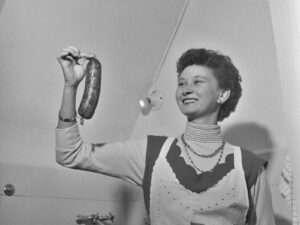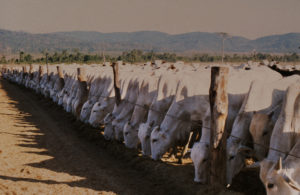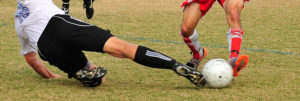
Wikimedia
Beauty and the Beast
Urs Althaus played for FC Zurich before kicking off his career as a model and actor. Rolf Bollmann regularly ‘kicked off’ on the pitch. His opponents even had a song about it.
In 1973, when Urs Althaus first showed up at Basel’s St Jakob Stadium, he was met with wild applause. The son of a Nigerian father and a Swiss mother, born and raised in Altdorf, was only there as a spectator. The audience had mistaken him for Peruvian international star Teofilo Cubillas, whose transfer to FC Basel had been announced. Althaus too had hoped to progress to that level, but he was unable to make an impression among the pool of young talent at Basel. FC Zurich gave him a new opportunity. Between 1973 and 1976 he played in the Zurich reserve team, and often trained with the 1st team. He was also training as a travel agent. Quite by chance, he was invited to take part in a fashion show for a sports store. And that was how he stumbled into his international career. Althaus was so successful on the catwalk that in 1977, he had the distinction of being the first black model to grace the cover of lifestyle magazine GQ, and later founded his own agency in New York.

Urs Althaus in the colours of FC Zurich…
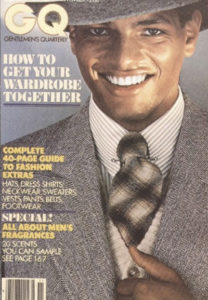
…and on the cover of US lifestyle magazine GQ, 1977.
Urs Althaus became especially well known in Italy, where people still call him ‘Aristoteles’, the name of the Brazilian hero in cult football film ‘L‘allenatore nel pallone’. Althaus played a leading role in the film, and football greats such as Zico, Carlo Ancelotti and Nils Liedholm appeared in cameos. The film pops up on TV at least once a year, and the Uri native is still a popular interviewee whenever Swiss teams play against Italian teams. But it wasn’t just in a football jersey that Urs Althaus looked good – he also cut quite a dash in a monk’s cowl. In 1986 he starred as Venantius von Salvemec alongside Sean Connery in the film adaptation of Umberto Eco’s ‘The name of the rose’. The world’s first black male supermodel told his unusual life story in a biography. Published in 2009, the book is tellingly entitled Ich, der Neger (I, the Negro).
Urs Althaus became especially well known in Italy, where he played a Brazilian hero in the cult football film ‘L‘allenatore nel pallone’.
YouTube
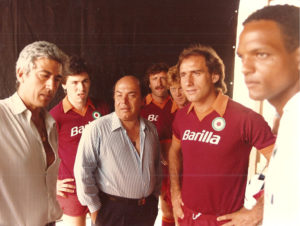
While shooting a film, Urs Althaus met football greats such as Carlo Ancelotti (second from left) and Francesco Graziani (second from right).
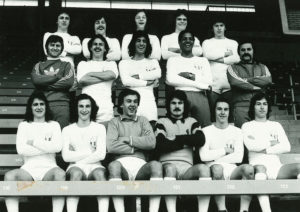
Team picture of FC Zurich 1974/75.
FCZ Museum
ROLF BOLLMANN, THE BEAST
These days, footballers are surrounded by campaigns warning them to play fair, and referees are quick to pull out a card if there’s any suggestion of over-the-top play. But that hasn’t always been the case. Take Rolf Bollmann, for example – as founder of the commuter newspaper 20 Minuten and later co-publisher and CEO of the newspaper Basler Zeitung, Bollmann went on to become a successful businessman. In the 1970s, however, he was described as the ‘biggest thug in Swiss football’. The Winterthur defender’s specialities: using his elbows, jabbing his opponent’s backside during a free kick, grabbing their testicles – brutal things, as he later admitted.
In his first international match, against Belgium, Bollmann forgot to bring his contact lenses from the team hotel, but didn’t say anything. As a result, he had to stand extremely close to his opposite number, Lambert, and ‘hold onto the man by the lower regions’. Although he missed several high passes, Bollmann got decent grades for his debut. When he later confessed his slip-up to national team coach Hüssy, the latter said empathetically: ‘You’re an arsehole!’ and never played him again.
So Bollmann’s highlight was the Cup Final with FC Winterthur (1:2) the following year, for which he got himself in the mood by drinking coffee laced with slimming drops and amphetamines. It wasn’t long before that particular combination made its effects felt: foaming at the mouth, Bollmann spent the first ten minutes running after his fellow defenders instead of his opposite number, Basel striker Ottmar Hitzfeld.
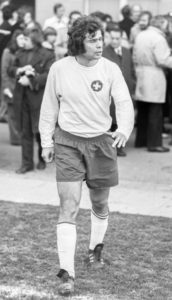
Bollmann in the colours of the Swiss national B team, 1973.
Keystone/STR

Rolf Bollmann (right) competes for the ball with Ottmar Hitzfeld, 1975 Cup Final.
Keystone/STR


